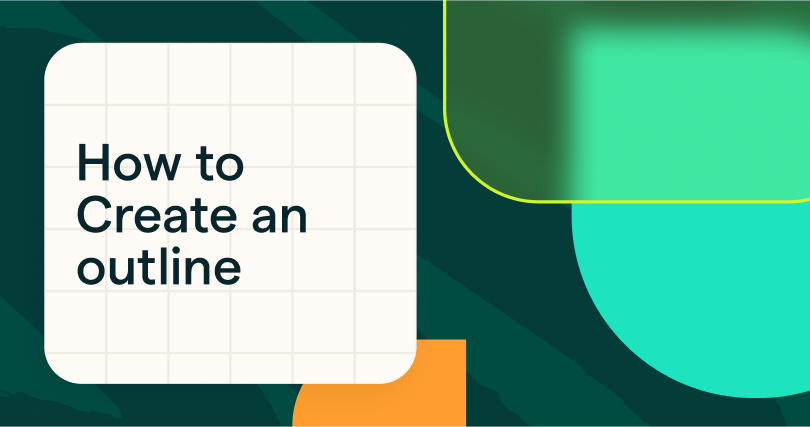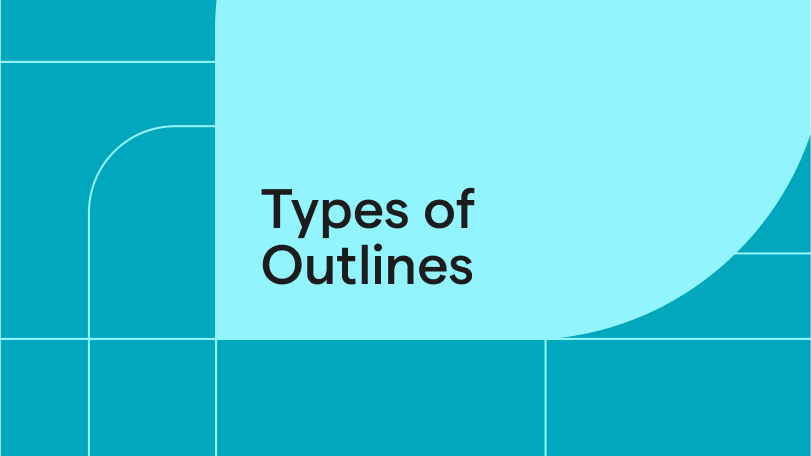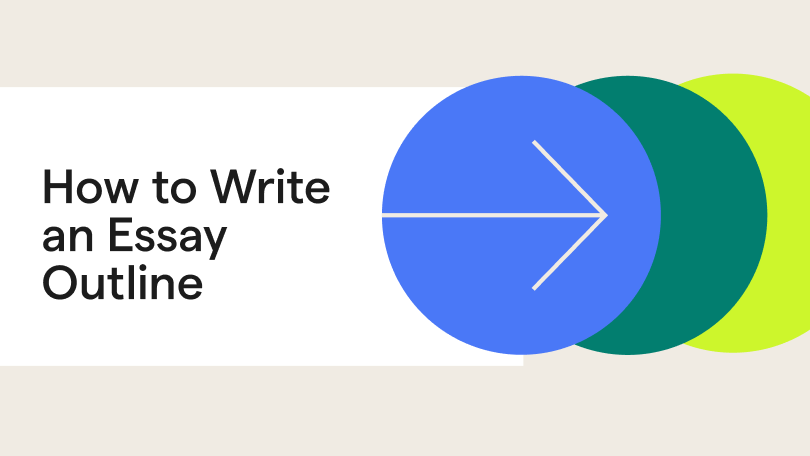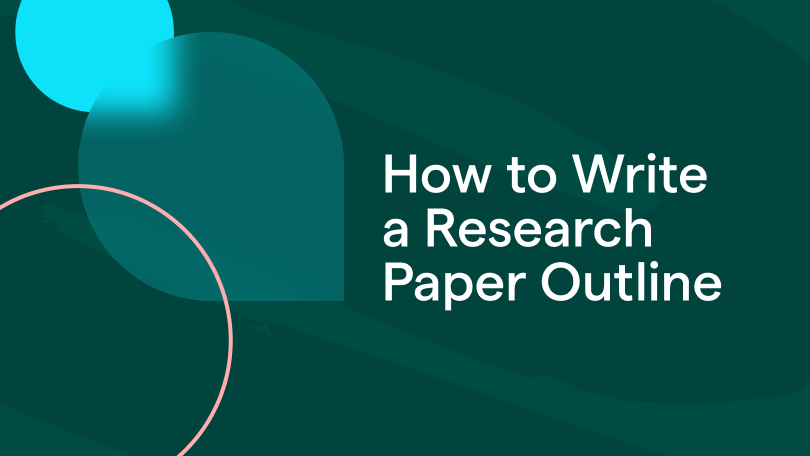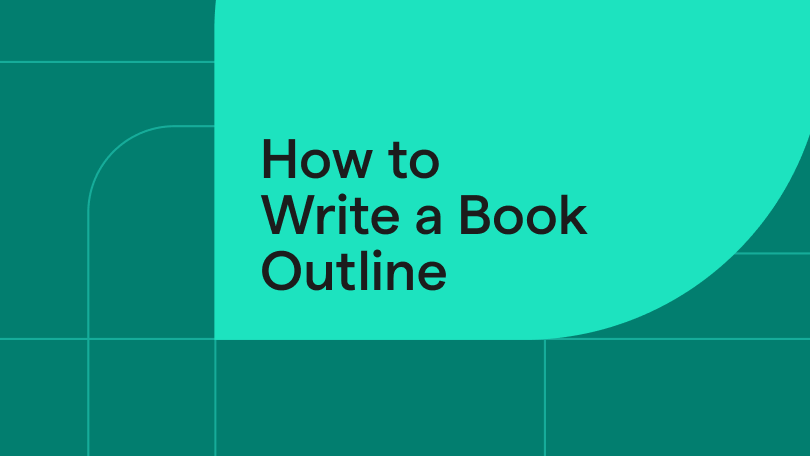What is outlining? Tips to structure your ideas
Outlining is the process of organizing your ideas into a clear, logical structure before you start writing. A well-crafted outline helps you structure your content, clarify how different sections relate, and decide the best order for presenting information. Follow our outlining guide for strategies to help you structure your ideas with ease.

Definition of outlining
Outlining is the stage of the writing process where you organize your notes, research, and main ideas in a logical order, usually using bulleted or numbered lists.
Outlining simplifies complex topics by breaking them down into the main points and sub-points, creating a roadmap for your writing project. This stage helps you overcome the blank page by organizing your thoughts in the most effective order, which can then serve as a jumping-off point for writing a rough draft. Outlines can be simple lists of notes or detailed documents, depending on your needs.
Ready to start your outline? Try Grammarly’s free AI outline generator. Just provide a few details about your topic, and it will create a starter outline for you to refine.
Outlining simplifies complex topics by breaking them down into the main points and sub-points, creating a roadmap for your writing project. This stage helps you overcome the blank page by organizing your thoughts in the most effective order, which can then serve as a jumping-off point for writing a rough draft. Outlines can be simple lists of notes or detailed documents, depending on your needs.
Ready to start your outline? Try Grammarly’s free AI outline generator. Just provide a few details about your topic, and it will create a starter outline for you to refine.
Free AI Outline Generator
Creating clear, structured outlines has never been easier. With our AI outline generator, you can instantly generate organized frameworks for essays, blog posts, research papers, presentations, and more.

Access additional features
Download Grammarly to improve your writing and instantly generate emails, documents, and more in your preferred voice.
Benefits of outlining
Creating an effective outline can make the entire writing process smoother and faster by keeping your communication goals and most important points in mind.
Stay focused and structured
A strong outline acts as a roadmap, helping prevent tangents, missed points, and last-minute scrambles.
Write faster with a clear plan
An outline helps you break down each part of your project into manageable pieces. Spend less time worrying about order and flow and more time getting your thoughts down on paper.
Create a clear, logical progression
Outlining helps you arrange ideas in a logical way to strengthen your main idea.
Spot opportunities for improvement early
Outlining reveals areas where your argument, evidence, or story needs more development, helping you address areas where you need more research or ideation early on.
Types of outlines
Whether you’re planning a business report, essay, or blog post, the correct outline sets the stage for clear, organized writing. We’ll walk through the six main types of outlines so you can choose the best structure for your project and writing process.
Formal outlines
Alphanumeric outline
Best for: Academic writing
This outline organizes your content using a mix of Roman numerals, letters, numbers, and lowercase letters. It’s ideal for academic writing, such as essays and research papers.
This outline organizes your content using a mix of Roman numerals, letters, numbers, and lowercase letters. It’s ideal for academic writing, such as essays and research papers.
Decimal outline
Best for: Technical writing
The decimal outline uses a progressive numbering system to map your ideas. Its precise hierarchy is best for situations that require strict order, like scientific or technical writing.
The decimal outline uses a progressive numbering system to map your ideas. Its precise hierarchy is best for situations that require strict order, like scientific or technical writing.
Sentence outline
Best for: Speeches
A sentence outline is written with full sentences rather than bullets or topics. It’s helpful when you have specific sentences in mind or want to convey a specific mood, such as when preparing a speech.
A sentence outline is written with full sentences rather than bullets or topics. It’s helpful when you have specific sentences in mind or want to convey a specific mood, such as when preparing a speech.
Informal outlines
Topic
Best for: Brainstorming
Topic outlines rely on concepts or short phrases. They’re useful for sketching out ideas or brainstorming.
Topic outlines rely on concepts or short phrases. They’re useful for sketching out ideas or brainstorming.
Working outline
Best for: Long-form writing
Working outlines are basic lists of your ideas that can be easily rearranged. You might create a working outline to get all of your ideas down so you don’t forget. These outlines are perfect for long projects, like academic or fiction writing.
Working outlines are basic lists of your ideas that can be easily rearranged. You might create a working outline to get all of your ideas down so you don’t forget. These outlines are perfect for long projects, like academic or fiction writing.
Reverse outline
Best for: Revising drafts
Reverse outlines happen after you’ve written your draft and involve pulling out the main points and sub-points in your draft. Think of them as a test to spot flow, logic, and clarity issues.
Reverse outlines happen after you’ve written your draft and involve pulling out the main points and sub-points in your draft. Think of them as a test to spot flow, logic, and clarity issues.
How to create an effective outline
An effective outline helps you organize your ideas and stay focused. Before you begin, clarify your writing project’s goal, gather ideas, conduct research, and look for patterns in your ideas to guide your structure. Then, follow these six steps to build a strong outline:
- Define your central idea: Craft a clear, compelling statement for your main idea.
- Decide on your structure: Choose the right outline format for your needs. Formal outlines are best for complex documents and research papers. Informal outlines are great for creative writing or early-stage planning.
- Plan your major sections: Lay out your main points as main sections. These will become the core of your outline.
- Add your evidence: Under each main section or subheading, add important data, examples, or facts that support your central idea.
- Check your flow: Does each section make sense, add value, and connect logically to the next?
- Revise: To improve your argument, you might need to add, move, or remove sections. Your initial outline will likely change over time.
Outlining with Grammarly's AI
Organizing ideas can feel overwhelming, especially when you have too many thoughts and no clear structure. AI can help by turning that chaos into order with a simple prompt. As a benefit, it’ll help you save time on planning your writing and allow you more time to write with direction.
With AI, just input your brainstorming notes—half-formed ideas, bullets, questions—into the prompt and ask for a structured outline on your topic. You can then refine the output into a working outline.
That’s where Grammarly’s AI comes in. It’s built by professional writers and linguists to support every step of the writing process, including outlining. Grammarly goes beyond just generating outlines–it supports you through every stage of the writing process. Whether you’re brainstorming ideas, organizing your thoughts into a structure, drafting paragraphs, or refining your final version, Grammarly helps you stay focused and in flow, all within the apps where you already write.
Here’s how Grammarly supports your outlining process:
With AI, just input your brainstorming notes—half-formed ideas, bullets, questions—into the prompt and ask for a structured outline on your topic. You can then refine the output into a working outline.
That’s where Grammarly’s AI comes in. It’s built by professional writers and linguists to support every step of the writing process, including outlining. Grammarly goes beyond just generating outlines–it supports you through every stage of the writing process. Whether you’re brainstorming ideas, organizing your thoughts into a structure, drafting paragraphs, or refining your final version, Grammarly helps you stay focused and in flow, all within the apps where you already write.
Here’s how Grammarly supports your outlining process:
Generates an outline instantly
Grammarly helps you organize your thoughts by instantly generating an outline from your notes or a simple prompt. In just a few clicks, it creates an outline for you to build on.
User enters a prompt to draft an outline on the impact of social media exposure on the teenage brain

Clarifies your ideas
Once you have a rough outline, Grammarly can offer suggestions to improve its clarity. Look for the text highlights on your document to review Grammarly’s clarity suggestions.
Spots gaps in your outline
When you’re reviewing your outline, you can prompt Grammarly to review your work and suggest improvements to your structure and supporting evidence.

A user using Docs to access Grammarly agents
Docs: Your thinking space and writing space, finally in one place
Docs is your dedicated writing surface for deep work. It’s a powerful AI document editor that supports your process from first thought to final draft, turning ideas into polished writing with real-time support at every step.
Learn more about docs
Learn more about docs
Outlining resources
Whether you’re looking for a step-by-step guide or specific advice for a school assignment, Grammarly has everything you need to create an effective outline.
Frequently asked questions
What is outlining in the writing process?
Outlining is the process of organizing your main ideas and supporting points before you start writing. It acts as a blueprint for your piece, helping you structure your thoughts, maintain focus, and create a logical flow from start to finish. A good outline makes the drafting process faster and smoother.
Ready to start outlining? Try Grammarly’s free outline generator to help you get started.
Ready to start outlining? Try Grammarly’s free outline generator to help you get started.
When should I create an outline?
Outlining usually comes after brainstorming and before you start writing a first draft. This step helps organize your thoughts and shape your direction. Sometimes writers also use reverse outlining to assess and improve structure after completing a draft.
How does outlining improve the writing process?
What are the 3 main parts of an outline?
The basic structure of an outline is composed of three primary components:
- The introduction: Introduces your main idea and sets context for your audience
- The body: Supports your main idea with evidence and arguments organized in a logical order
- The conclusion: Summarizes your main ideas and reinforces your main point
Do I need an outline for everything I write?
Outlining is recommended for longer or structured pieces like essays or reports because it helps keep you organized. For shorter or simpler writing, an informal outline or notes may suffice. Even a loose plan can boost your confidence, save time, and reduce the need for major rewrites later.
When should I use a formal outline versus an informal outline?
Use a formal outline for structured writing, like essays or reports. Use an informal outline when you’re brainstorming or planning.
Explore the writing process
Get support for every stage of the writing process. No matter where you are in your journey, Grammarly is your writing partner. Its AI supports you from ideation to final polish, and every step in between.
Brainstorming
Learn strategies for generating ideas and expanding your thinking. Tap into creative brainstorming methods and AI-powered suggestions that spark fresh angles and unexpected connections.
Learn More →
Learn More →

Rough draft
Unlock ways to make writing easier and more efficient. Get practical tips to overcome writer's block, maintain momentum, and use Grammarly’s AI to make rough drafts less rough.
Learn More →
Learn More →
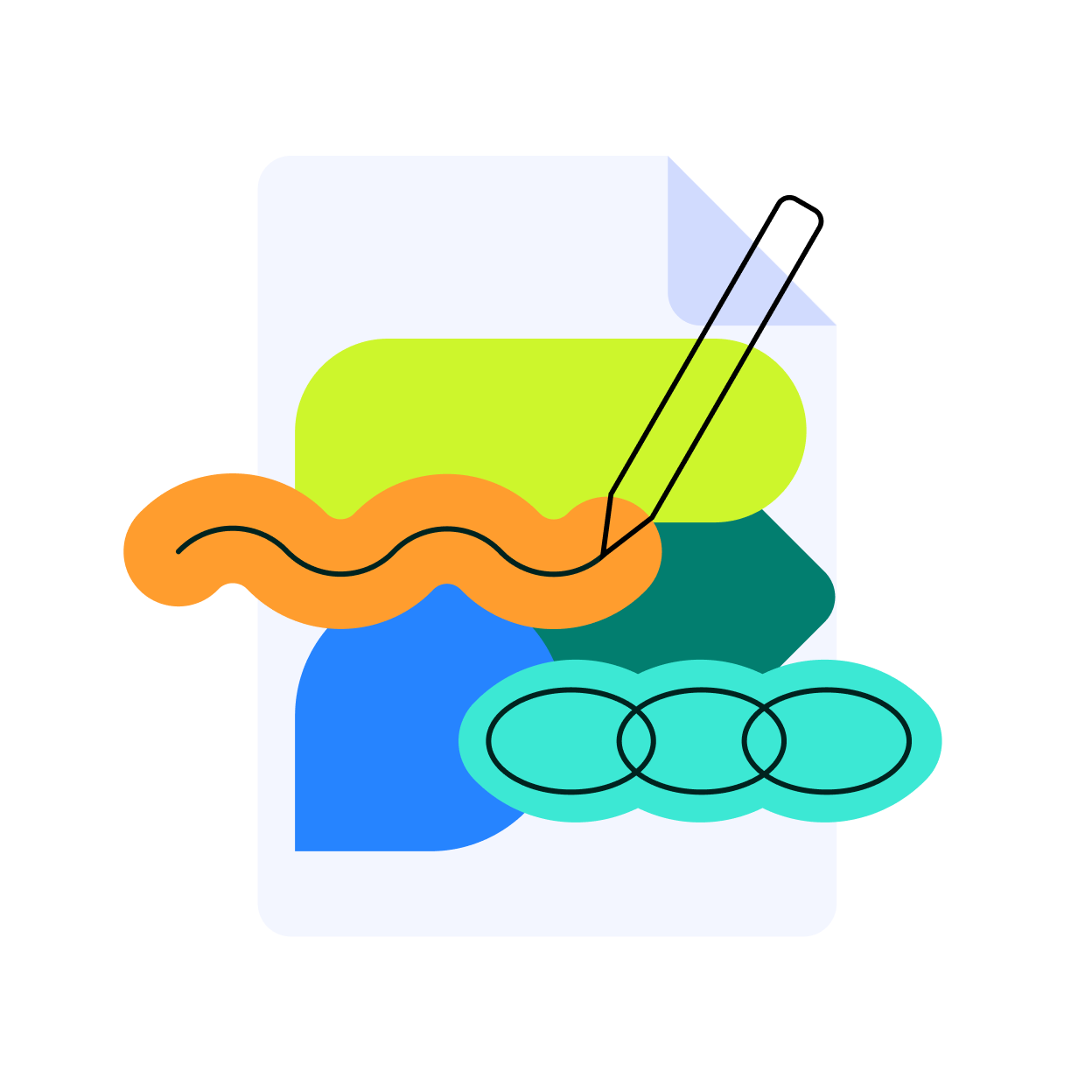
Revising
Explore the art and craft of editing for clarity, effectiveness, and style. Learn simple techniques to sharpen your writing and get dynamic suggestions to improve your impact from Grammarly.
Learn More →
Learn More →

Proofreading
Learn how to proofread your work effectively so your finished product is polished and ready for readers. Build your proofreading skills with step-by-step guides supported by the world’s best AI proofreader.
Learn More →
Learn More →

Brainstorming
Learn strategies for generating ideas and expanding your thinking. Tap into creative brainstorming methods and AI-powered suggestions that spark fresh angles and unexpected connections.
Learn More →
Learn More →

Rough draft
Unlock ways to make writing easier and more efficient. Get practical tips to overcome writer's block, maintain momentum, and use Grammarly’s AI to make rough drafts less rough.
Learn More →
Learn More →

Revising
Explore the art and craft of editing for clarity, effectiveness, and style. Learn simple techniques to sharpen your writing and get dynamic suggestions to improve your impact from Grammarly.
Learn More →
Learn More →

Proofreading
Learn how to proofread your work effectively so your finished product is polished and ready for readers. Build your proofreading skills with step-by-step guides supported by the world’s best AI proofreader.
Learn More →
Learn More →

Stay in flow with AI assistance that works where you do
Grammarly works across 1 million+ apps and websites, so you can go from idea to final draft without copying, pasting, or breaking focus.

